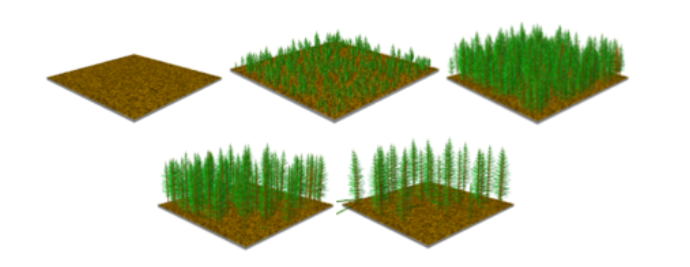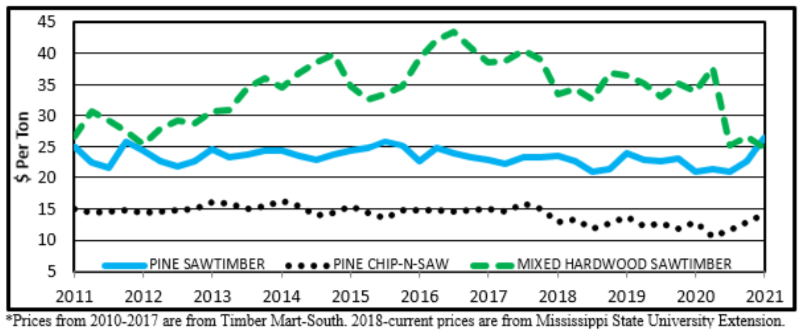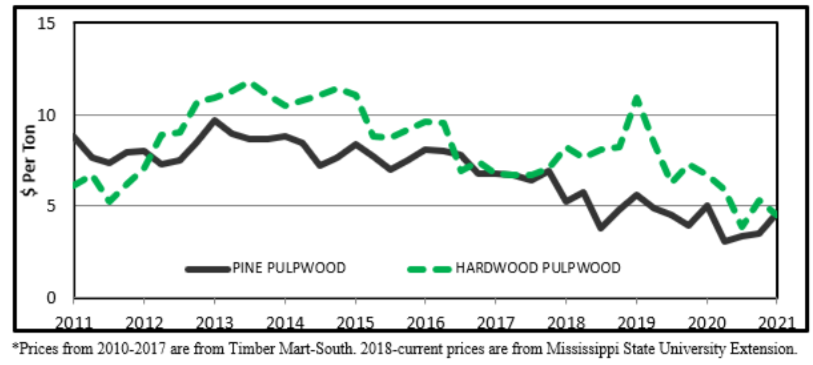Volume 10, Issue 2, June 2021
From the Coordinator's Desk
Brady Self, Extension Forestry Specialist
As spring yields to summer and COVID-19 restrictions loosen, we are observing renewed interest in face-to- face programming. While some of the County Forestry Associations across the state are still refraining from in person meetings, others are now meeting and seem to be experiencing high participation numbers. While we may not be out of the woods completely regarding COVID-19, thankfully, it looks as though we will continue to see less restrictions and be able to return to some of our more traditional programming.
In other news, we have refilled the Extension Forestry Specialist position vacated in early 2019 by Dr. Stephen Dicke. Dr. Curtis VanderSchaaf started June 1 and will serve the SW Mississippi counties out of the Central Mississippi Research and Extension Center in Raymond. Curtis earned his PhD from Virginia Tech in forest biometrics and specializes in growth and yield analysis as well as decision modeling. Please extend your welcome to Curtis as he makes his way around the state and feel free to contact him if you need any help.
What Forest Growth and Yield Modeling Is, and How it Might Be Useful to Landowners and Managers
Curtis VanderSchaf, Extension Forestry Specialist
Forest management decisions are based on existing site resources but often more on what will exist in the future. What do we need to do today to achieve our future desired forest condition? We don’t know with certainty what our stand will be like in the future. However, we often can estimate with reasonable certainty future conditions of our stand/forest/landscape, etc., based on past observations in both our own forest and others like it. Stated differently, we can use growth and yield models.
These models are systems of mathematical equations representing biological process – for example, the amount of volume. Where growth refers to change, and yield refers to what is observed at a particular point in time, or what can be harvested today or at some other point.
For instance, if our site has a site index of 65 feet, was planted at 500 seedlings per acre, and had intensive site preparation, we can find other sites with the same or similar characteristics that are older than our own stands and then make observations within them. We can then use those observations to infer how our forest of interest will grow. Notice, the word infer. We never know for sure how a forest will grow, but we have some knowledge of future potential based on observations from similar forests further along in development.
For the most part, we can’t predict with 100% certainty because other forests, will have variables besides those being used for prediction that differ from our current forest of interest. This will cause their development to differ slightly from ours. For instance, using the example above, perhaps the genetic stock, elevation, or adjacent land use differs. All of this will create variation among forested stands despite similarity of characteristics (e.g. site index, planting density, and site preparation). Additionally, sometimes errors in statistical modeling can reduce our accuracy. Nonetheless, growth and yield models based on observations of behavior from similar forests are probably the most commonly used approach to obtain future projections.
In order to develop models to obtain projections, we must first ask what is it that we want to know in the future? Do we want to know the number of surviving trees, how height will develop, or do we simply want to know total merchantable volume, etc.? This will have an impact on what mathematical equations we use. Then, we must ask ourselves what variables we need to measure and/or predict, to obtain projections of those variables that we are interested in. This will help determine mathematical model/equation form.
Finally, often we need to decide how biology “behaves.” For example, one person may feel planting stock (container versus bareroot) has no impact on yields, and another may strongly believe it does. Thus, planting stock may be excluded from a mathematical model simply due to personal bias. Hence, modeling is often an art and not an exact science.

Mississippi Timber Price Report - 1st Quarter 2021
Marc Measells, Senior Extension Associate
The Mississippi Timber Price Report provides a picture of timber market activity across the state showing regional and statewide stumpage prices for common forest products. This report should only be used as a guide to help individuals monitor timber market trends. The average price should not be applied as fair market value for a specific timber sale because many variables influence actual prices individuals landowners receive. This report and previous historical timber prices are available by contacting your local county Extension office or at: www.extension.msstate.edu/forestry/forest-economics/timber-prices.
1st Quarter 2021 Stumpage Prices/Ton (Source: MSU Extension)
NOTE: Prices vary widely across the state; average prices presented here may not reflect your local market.
Pine Poles - $40.20
Pine Sawtimber - $26.50
Pine Chip N Saw - $14.08
Pine Pulpwood - $4.57
Oak Sawtimber - $39.38
Mixed Hardwood Sawtimber- $24.80
Crossties - $28.89
Hardwood Pulpwood - $4.54
Price Trends:
As is typical in Mississippi during the 1st quarter, areas of the state had above normal rainfall, especially during March. Prices typically increase the 1st quarter as wetter weather conditions prevail. Landowners with land that could be harvested during wet weather benefited. The 1st quarter statewide stumpage prices for pine products are in Table 1 and hardwood products are in Table 2. Figures reflect 10-year statewide average price trends.
Compared to the 4th quarter, statewide average prices changed (-14.8% to 28.8%) during the 1st quarter with most product classes having higher prices. However, prices varied for some product classes across regions. Record lumber prices have continued into 2021. However, our abundant oversupply of standing timber continues as the main contributor to stumpage prices not increasing as rapidly as lumber prices. The good news, statewide average stumpage prices compared to the previous year (1Q 2020) for pine sawtimber increased 26.5% and pine chip-n-saw increased 9.1%. Unfortunately, hardwood product prices have continued to struggle.
The unemployment rate, although still high, has continually decreased since April 2020. As unemployment rates and the overall economy continue to improve, timber markets should slowly recover. Housing starts have fluctuated since December 2020. As record lumber prices have increased new home prices, expect housing starts to fluctuate more in the coming months as more people delay new home construction. This will possibly lead to a market reduction on lumber prices. Stumpage prices during the 2nd quarter are not expected to change much. Most economic forecasters still expect the recovery to continue throughout 2021. As noted in the previous report, construction of new mills and mill expansions will benefit Mississippi landowners. The increased competition from these new mills are much needed! Keep in mind, we still face an enormous overabundant supply of standing timber in Mississippi which will restrain stumpage price moving forward.


Kudzu: The Plant We Love to Hate
John Kushla, Extension Forestry Specialist
Our story begins 145 years ago, at the World’s Fair Centennial Exposition in Philadelphia, Pennsylvania. There on display was an exotic plant from the Orient. It had a beautiful bloom and wonderful fragrance. We know it as kudzu (Pueraria montana). For decades, this vine remained a horticulture novelty. What happened to make this plant spread across the southeast?
Poor farming practices had exposed the nation’s soils to erosion by rain, snow, and wind. By the 1930s, we were facing a crisis of soil loss. In the Great Plains, land was blowing away in a series of events called the Dust Bowl. The United States Department of Agriculture (USDA) mobilized its resources to combat soil erosion.
In the South, the USDA focused on using kudzu for erosion control and forage production for livestock. Scientists learned that it was capable of fantastic growth, up to 60 feet a year. Moreover, it was a legume, capable of fixing atmospheric nitrogen.
Consequently, kudzu improved soil fertility and made nutritious forage. So, the USDA promoted planting kudzu widely across the South well into the 1950s.
Gradually, scientists realized that kudzu is an invasive plant. Like other invasive species, kudzu is extremely aggressive in taking over a site. It displaces native vegetation by killing it or preventing its regeneration. Like many invasive species, kudzu is difficult to kill. It has a tuberous starch-storing root that makes the vine very hardy. Once established, no available herbicide will control kudzu with one application. Therefore, control requires repeated applications over consecutive years. Herbicides and rates vary with age of the kudzu patch and the non- target species it is covering. Follow all label directions when using herbicides.
There are government programs to help forest landowners control kudzu. Both the USDA Natural Resources Conservation Service and the Mississippi Forestry Commission have landowner assistance programs for controlling non-native invasive plants. In addition, the Mississippi Department of Transportation and USDA Forest Service have ‘good neighbor’ programs to control invasive plants bordering private property. For more information on controlling kudzu or other non-native invasive plants, contact your local Extension office.
Delta Hardwood Notes: Why Did They Leave Those Trees?
Brady Self, Extension Forestry Specialist
A question that pops up from time to time when working the Delta is, “Why did they leave those trees?” We have all seen these “islands” of trees tucked away in various agricultural fields around the state. Naturally, the inquisitive mind questions why these small forests were left uncut. They vary in size, sometimes a single tree, but usually ranging between a few stems to a few acres in size. They are seemingly in the way of agricultural operations, a waste of ground, or just out of place. The presence of these small forested stands can be due to several varying factors.
Often these pockets of trees were simply left because they occupied ground that was unworkable or unprofitable for soil tillage. It is common to find that these tracts cover depressions and that they possess saturated soils for much or all of the growing season. These spots were simply left unworked and, if ever cleared, naturally regenerated over time. Even in drought years when water is scarce, onsite vegetation will reveal the typically wet nature of these places. It is common for these stands to have existed for decades or longer, and while the better quality timber may have been removed at various intervals, the area was never put into agricultural production.
Other reasons for these sites exist including the presence of old home or cemetery sites, shade spots for livestock and field hands, soil differences of some type, etc. Sometimes, with a little investigation, one can find the original reason for their existence. However, oftentimes the reason for their presence is a mystery lost to time.
If you have a favorite "tree island" that you know of, please visit our Facebook page and tell us about it!
Upcoming Events Fall 2021
Herbicide for Pine Management Virtual Workshop
9:00am - 10:30am July 13, 2021; Virtual workshop via Zoom
FREE - Pre-registration required
Would you like to learn more about appropriate herbicide and application rates for pine management? This FREE workshop is intended to inform attendees of current herbicide applications available for use in pine management efforts. For questions and help with RSVP/pre-registration, please contact Doug Carter with the Rankin County Extension Office at 601-825-1462.
Mid-South Forestry Equipment Show
September 17-18, 2021; Starkville, MS
Pre-Registration (closes Sept. 6): $20, Day-of registration: $25
The Mid-South Forestry Equipment Show is the Deep South’s premier forestry show. It is the oldest outdoor, live logging demonstration in the nation where equipment manufacturers are allowed to operate their equipment in actual field conditions. The show has been in operation for over 35 years providing a grass- roots technology transfer between loggers, landowners, foresters, and equipment manufacturers. The two- day attendance for the past six show events has averaged 6,000 participants.
Primary Business Address
Mississippi State University
Forestry Extension
P.O. Box 9681
775 Stone Blvd
Mississippi State, MS 39762
Contact: Ms. Laura Terry
let181@msstate.edu
662-325-2946
Fax: 662-325-0027
Regional Personnel:
NE District: Dr. John Kushla
662-566-8013, or John.Kushla@msstate.edu
NW District: Dr. Brady Self
662-226-6000, or brady.self@msstate.edu
SW District: Dr. Curtis VanderSchaaf
SE District: Mr. Butch Bailey
601-794-0671, or asb1@msstate.edu
SE District: Dr. Shaun Tanger
228-546-1014, or smt489@msstate.edu
Campus Personnel:
Professional Logging Manager, Tree Farm and SFI: Dr. John Auel
662-325-7948, or jba9@msstate.edu
Timber Prices, Economics, Certification: Mr. Marc Measells
662-325-3550, or mkm2@msstate.edu
Media: Ms. Laura Terry
662-325-2946, or let181@msstate.edu



